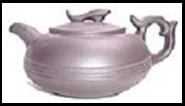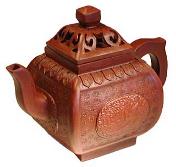|
The Art of Tea Drinking
|


Types of TeaTea is made from the young, tender leaves of the tea tree. The differences among the many kinds of tea available are based on how the leaves are processed. The major methods are fermentation and roasting. Through fermentation, the originally deep green leaves become reddish-brown in color. The longer the fermentation, the darker the color becomes. Depending on the length of the roasting and degree of fermentation, the fragrance can range from floral, to fruity, or malty. |
|
Benefits of Tea Chinese tea is healthy in a lot of ways. It has antioxidants, tannic acid known for its anti-inflammatory and germicidal properties, and recent medical researcher found it contains polyphenols which help fight cancer. Tea also has caffeine, a stimulant for the nerve center and increasing metabolism. Tea can lowering cholesterol and blood pressure, preventing heart disease, cancer, and Arthritis, eliminating constipation, inducing weight loss, preventing tooth decay. ( Continued on next page. Please click here …. ) |

|
It is interesting to note that the two different pronunciations for "tea" most common in languages were borrowed from the Chinese words - cha and tee – which originated from different dialects of Chinese. Countries that once imported tea from the northern China, such as Turkey, Russia, and Japan, adopted some variations of the sound cha, such as chay, chai, or chya. Countries imported tea from the coast of southern China, such as Spain, Germany, and England borrowed the word tee in the forms of te, tee, and tea respectively, based on the southern Chinese pronunciation. |

|
A Brief History The custom of drinking tea has been part of Chinese way of life for centuries. During the mid-Tang Dynasty (618-907 A.D.), a Buddhist monk named Lu Yu was best known for summarizing the knowledge and experience of his predecessors and contemporaries into the first compendium in the world on tea - the Tea Classic ( Ch'a Ching). |
|
Different degrees of fermentation produce four types of tea: · Not-fermented: Green tea, like Long-Jing(Dragon Well), Bi-Lou-Chun (Green Spring Snail), Yu-Hua (Rain Flower) · Light-fermented: Oolong, Jasmine · Medium fermented: Tie-Guan-Yin (Iron Guan-Yin), Don-Ting Oolong (Frozen Peak Oolong), Wu-Yi Da-Hong-Pao (Big Red Robe) · Heavy fermented: Pu’er, Oriental Beauty · Fully fermented: Black tea, like Lao-Qing-Ye (Old Green Leaf) |


|
This work helped to popularize the art of tea drinking all across China, making avid tea drinkers of everyone from emperor to street hawker. Even the neighboring countries, such as Korea, Japan, and Southeast Asia countries, adopted the tea drinking custom. In the early 17th century, the Dutch East India Company introduced Chinese tea for the first time to Europe. By the mid-17th century, afternoon tea had become a standard ritual of the British aristocrats. |


|
Year of OX Feb 20-28 ~~~~~~~~~~~~~~~ Learn more about the art of tea drinking ~~~~~~~~~~~~~~~ Learn more about the art of Chinese Flower Arrangement |

|
[ Home ] [ About Us ] [ Contact Us ] [ Events ] [ Archived Events ] [ Flower Arrangement ] [ Art of Tea Drinking ] © Copyright Hanlin Chinese Culture Association, Hockessin, DE 19711 |